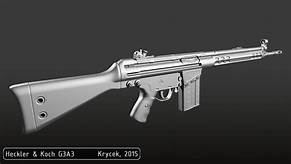
 0
0 
Heckler and Koch’s G3 rifle might be the valid “AK of the West” in numerous ways. While the FN FAL acquired the moniker “right arm of the free world” and accomplished an equivalent emblematic noticeable quality in the West as the Kalashnikov did in the East, the two weapons are not precisely indistinguishable. The adaptable gas framework and non-compatible parts between designs make the FAL very touchy to be really contrasted with the AK, while the equivalent can’t be said to describe the G3. The H&K G3 might be the fight rifle that truly has the right to be contrasted with the FAL on the grounds that it is all the more generally embraced, more dependable, and simpler to produce. The roller-deferred blowback activity that is at the core of the G3 rifle was brought into the world in Germany, however, it needed to invest some energy in France and Spain before at last getting back. You can peruse our set of experiences of the CETME Model 58 to find out with regards to the group of Mauser engineers who in the long run carried the stage to fulfillment.
The short clarification is that when fostering the StG 44 and StG 45, the Germans nearly coincidentally found the idea of roller-postponed blowback (M). Since the Mauser engineers were by all accounts not the only ones who recognized the capability of this original system, the roller-deferred blowback activity was saved from annihilation when Germany lost the conflict and its innovation and information were shared with the partners. The first makers of the framework had the option to proceed with their work in France under CEAM, and subsequently in Spain under CETME. While the CETME had some achievements, it wasn’t until the plan was permitted to get back to its starting point that the idea was completely acknowledged and executed, those acquainted with the CETME will realize that the first plan goal was to utilize a halfway force cartridge as the StG 44 did to proceed with improvement of the attack rifle as an idea, however very much like the FAL and M14, the last emphases of the CETME wound up being loaded for the new NATO standard—7.62x51mm. While it was America’s impact that drove NATO to embrace the full power cartridge, it was the Bundeswehr’s advantage in the CETME stage and their emphasis on NATO consistency that prompted the most productive CETME Model C variation.
The G3 rifle was for all intents and purposes unclear from a Spanish-made CETME when it was first sent by the Bundeswehr. This was generally attributable to the early utilization of wood furniture on the two guns, which would be supplanted by polymer on the G3 in the mid-1960s. Different contrasts between the G3 and the CETME incorporate the establishment of conventional HK-style drum sights and new internals for the terminating control bunch.
H&K would keep on fostering the G3 all through time, bringing about varieties with bipods, collapsing stocks, and more limited barrels. The unbelievable PSG1 marksman rifle and the HK21 broadly useful automatic weapon were both dependent on the G3 rifle, similar to the AK, maybe the greatest marker of the G3’s prosperity comes from the sheer number of rifles that have been created and multiplied throughout the long term. Other than being made by H&K in Germany, authorized duplicates have likewise been delivered by twelve different countries including Greece and Turkey, throughout the long term it has been taken on by in excess of 80 public armed forces and a few non-state entertainers also. While the FAL might have been at first embraced by a bigger number of nations than the G3 rifle, the G3 has more dynamic clients today. Other than figuring out how to remain in far-reaching administration for longer than the FAL, ongoing photographs from the world’s contention zones additionally let us know that the G3 is even more predominant among guerrillas too. Since basically the 1960s, the G3 rifle has shown up in a large portion of the world’s huge contentions. From different African bramble wars, clashes in Northern Ireland, and the Global War on Terrorism, G3s have had an influence.
CONCLUSION:
Whether by professional armies, insurgent forces, or civilian sports shooters, the G3 rifle is still commonly used today. The former two continue to do so, owing to their availability and relatively cheap, but they’re nevertheless thought to be extremely sturdy, reliable, and accurate. The platform’s versatility and dirt-cheap magazines are also appealing to today’s enthusiast shooters. Choosing a G3 to own might be difficult between antique imports and commercial models, but if you know what to look for, they can still be a good fighting rifle. This classic.308-thumper would be right at home in anyone’s arsenic with its functional attributes and vintage appeal.

 0
0